We may earn revenue from the products available on this page and participate in affiliate programs. Learn More ›
A water hose timer is one of the most helpful lawn care tools out there. When summer heat and drought threaten the yard and garden, a hose timer handles the watering schedule to keep them from drying out. Unlike irrigation system timers designed for expensive in-ground irrigation systems, these devices work with virtually any outdoor faucet and garden hose to control hose-end sprinklers, soaker hoses, and drip irrigation. Whether you choose a simple mechanical model or one that offers advanced control and monitoring features, a hose sprinkler timer applies the right amount of water and shuts off automatically.
We wanted to know which of the most popular hose timers on the market really deliver on their claims of simplifying watering, so we tested them ourselves. We selected 10 of the highest-rated models and tried them out in our yards and gardens. Our favorite was the Rain Bird Premium Hose End Timer, boasting a durable design and easy-to-program settings with a large digital display. Other picks offered different features that we liked, too, ranging from simple, mechanically-operated models to more advanced Bluetooth-connected types.
To be effective, timers for water hoses should be simple to use and allow for quick and easy watering whenever and wherever necessary. Ahead, we will share what we look for when shopping for a hose timer and why the following models earned a spot on this lineup of the best hose timers out there.
- BEST OVERALL: Melnor 63100 AquaTimer 2-Zone Digital Water Timer
Jump to Review - BEST BANG FOR THE BUCK: RainPoint ITV105 1-Zone Mini Digital Sprinkler Timer
Jump to Review - BEST MECHANICAL: Gardena 31169 Mechanical Water Timer
Jump to Review - BEST EASE OF OPERATION: Orbit 62056 One Outlet Single-Dial Hose Faucet Timer
Jump to Review - BEST DUAL-HOSE: Gilmour 804014-1001 Electronic Water Timer
Jump to Review - BEST SMART: RainPoint Smart Wi-Fi 2-Zone Sprinkler Timer
Jump to Review - ALSO CONSIDER: Instapark PWT-07 Digital Programmable Water Timer
Jump to Review
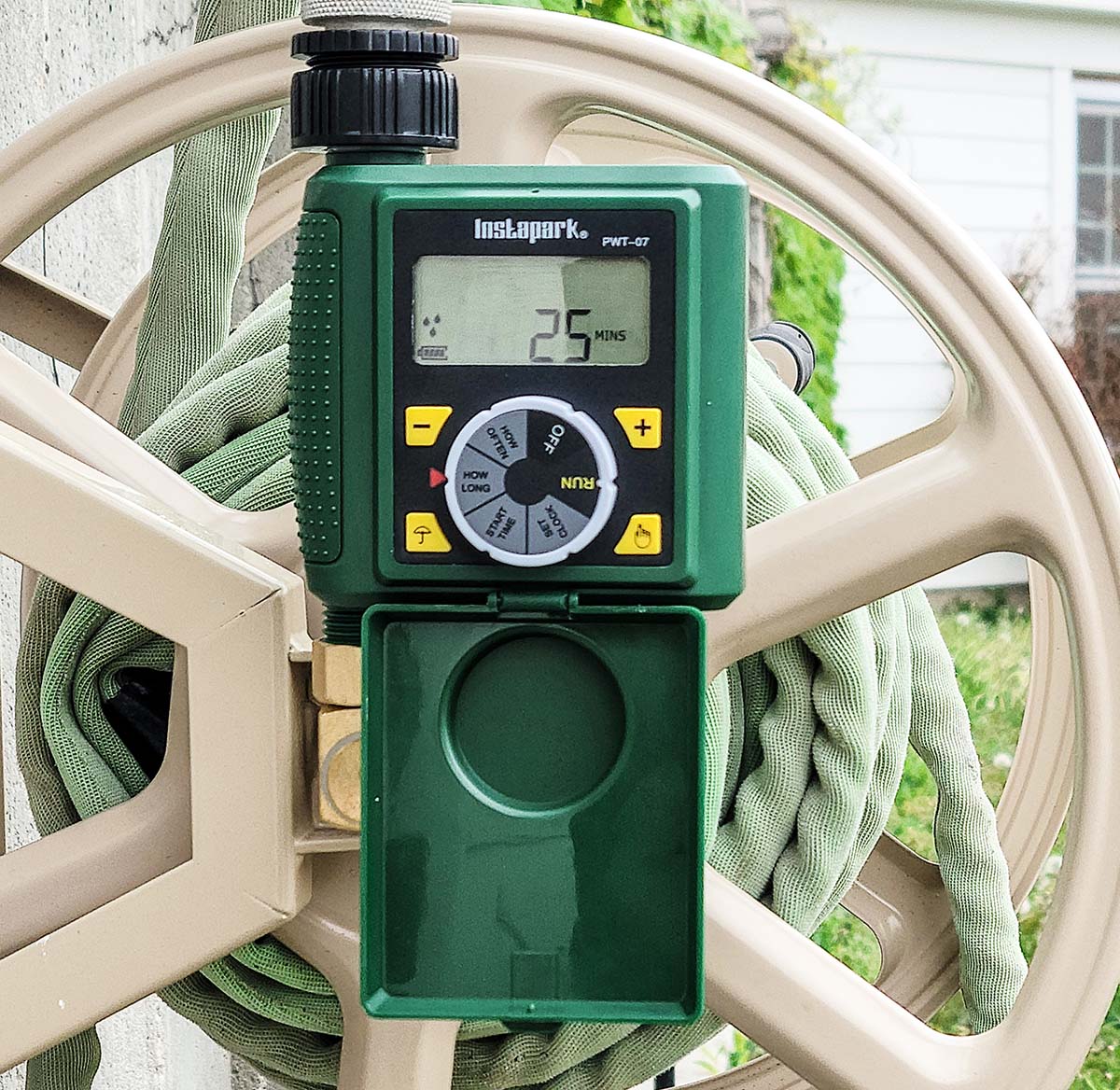
Hose Timers Comparison
Tips from a Pro Gardener
We interviewed Troy Smothermon, a fellow gardener with 20 years of experience and founder of StartOrganic in California, who shared some advice.
He suggests using “flexible lines, ideally with metal connections, to connect the timer to the hose outlet. Adding the timer directly onto the end of a hose bibb can be a breaking point.”
He added that “flexible lines allow the timer to move, reducing accidental breaks and bumps when relocating the hose. Also, it’s not a bad idea to install a splitter or “Y” so you can still use your regular garden hose from the same hose bibb while your timer is installed.”
Our Top Picks
An automatic water timer helps ensure lawns and gardens don’t dry out or accidentally flood. The following models vary in type, price, and standard functions, but each earned a spot on our lineup by performing well in our hands-on tests. We included the pros and cons of each model to help determine which will best suit your watering needs.
Best Overall
Melnor AquaTimer 2-Zone Digital Water Timer
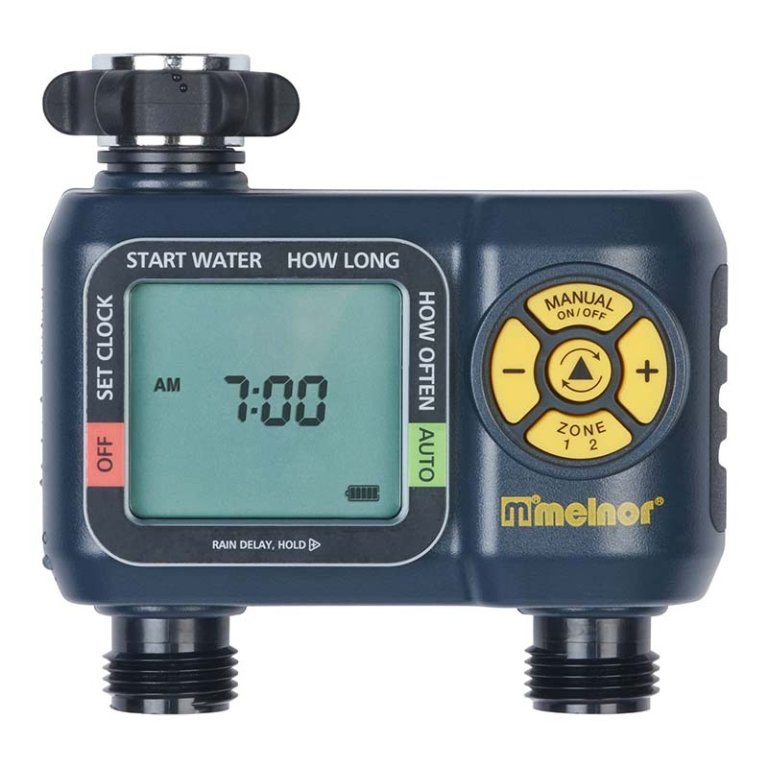
What We Like
- Easy to program and adjust with a large digital display and intuitive buttons
- Rain-delay function can pause watering for up to 7 days
- Dual watering zones can be individually programmed—ideal for those with differing watering needs
What We Don’t Like
- Batteries are not included and may require frequent replacement
- Water flow is not adjustable per zone—both zones will have the same water pressure
Product Specs
- Number of hose outlets: 2
- Watering duration: 1 minute to 6 hours
- Digital or manual: Digital
This Bob Vila Approved product carries our brand’s highest level of recommendation.

Bob Vila Approved recognizes the household and DIY products that impressed us most in our real-world testing and that exemplify core values of the Bob Vila brand, including craftsmanship, innovation, and value for the dollar. Winners of this designation come recommended by our professional review team and are personally approved by Bob Vila.
Our Ratings: Ease of Use 5/5; Performance 4/5; Durability 5/5; Value 5/5
Topping our lineup is the Melnor AquaTimer. It features two hose outlets and is an excellent option for watering more than a single zone.
In testing, we attached the AquaTimer to an outdoor spigot and connected two hoses to the bottom outlets. The fitting that connects to the spigot twists independently of the timer, which makes it simple to attach.
We found programming the AquaTimer to be self-explanatory. A central button in the middle of the control panel allowed us to scroll through the functions, and we used the plus and minus buttons to set the time as well as select when watering would begin and how long it would last. Watering duration is adjustable from 1 minute to 6 hours.
We created custom watering programs for each of the two zones. The first zone ran to a sprinkler in a flower bed, and we set the timer to water twice a day for 30 minutes each. For the second zone, we ran the hose to a large drinking bowl in our dogs’ play yard and programmed the water to come on twice a day for 2 minutes—just long enough to fill the bowl with fresh water. Having dual zones will be a boon for anyone with multiple watering needs, just as it was for us in our tests.
Once set, the AquaTimer runs the same watering schedule daily, but it also has a rain-delay function that allows you to pause the watering schedule if you don’t need to water that day. It also features a manual override function that allows you to water anytime.
The AquaTimer runs on two AA batteries (not included) and features a large easy-to-read LCD screen. Its primary downside is that flow strength is not adjustable per zone—if we wanted full-blast water for Zone 1, we also had it for Zone 2. For many, that likely won’t be a big issue. Overall, this little hose timer saves time and ensures the garden or pets always have a source of fresh water.
Read our full review: Melnor AquaTimer 2-Zone Digital Water Timer
Get the Melnor hose timer at Amazon, or Walmart.
Best Bang for the Buck
RainPoint ITV105 1-Zone Mini Digital Sprinkler Timer
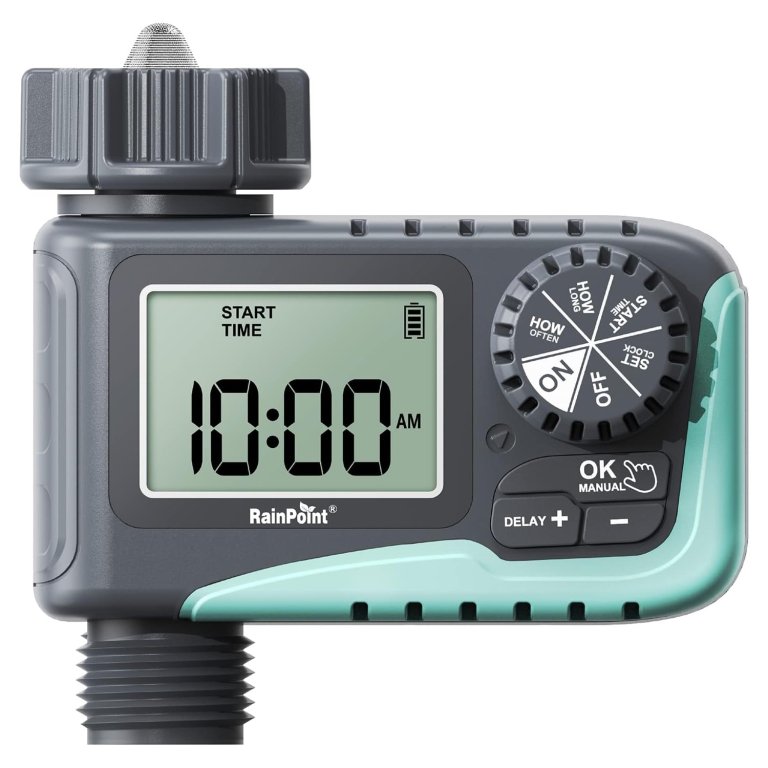
What We Like
- Compact design; this small hose timer is designed to fit in tight spaces
- Clear, easy-to-see LCD screen with large numerical display
- Offers manual override and rain-delay functions for versatility
What We Don’t Like
- The words on the dial and the buttons are small and can be challenging to read
- Compact size offers only 1 hose outlet, which limits use in larger yards or gardens
Product Specs
- Number of hose outlets: 1
- Watering duration: 1 minute to 3 hours and 59 minutes
- Digital or manual: Digital
Our Ratings: Ease of Use 3/5; Performance 4/5; Durability 4/5; Value 4/5
One of the biggest complaints from those with water spigots in hard-to-reach spots is that most standard hose timers are too large to connect. There’s always the option of attaching a short leader hose to the spigot, then attaching a timer between the leader hose and another garden hose. However, if you want a compact timer to use in restricted areas, the RainPoint Mini timer is a great option.
The RainPoint Mini uses two AAA batteries (not included) and has the same features as most larger timers. As a mini unit, it does only have one hose outlet, but for many watering situations, that’s enough. You can choose a watering duration between 1 minute and 3 hours 59 minutes. You can also adjust watering frequency to as often as once per hour or as little as once every 7 days.
We found the words on the RainPoint Mini’s dial on the small side, so rather than attach the timer to a spigot where we might struggle to read the dial, we opted to connect the unit between two hoses. This process was quite simple thanks to the RainPoint Mini’s easy-attach fitting. Unfortunately, this model’s plus and minus buttons were also small—it was easier to simply memorize which was which rather than trying to read them. Even though this tiny timer has a small dial and buttons, its LCD screen’s digital numbers are large and easy to see, even in bright sunlight.
To achieve the compact size, RainPoint does compromise on some features, such as separate buttons for manual override and rain delay (up to 72 hours). This small hose timer requires you to use the plus and minus buttons and set the dial to “On” to activate those features, whereas other timers have dedicated buttons for those actions.
Get the RainPoint Mini hose timer at Amazon, The Home Depot, or RainPoint.
Best Mechanical
Gardena 31169 Manual Mechanical Water Timer
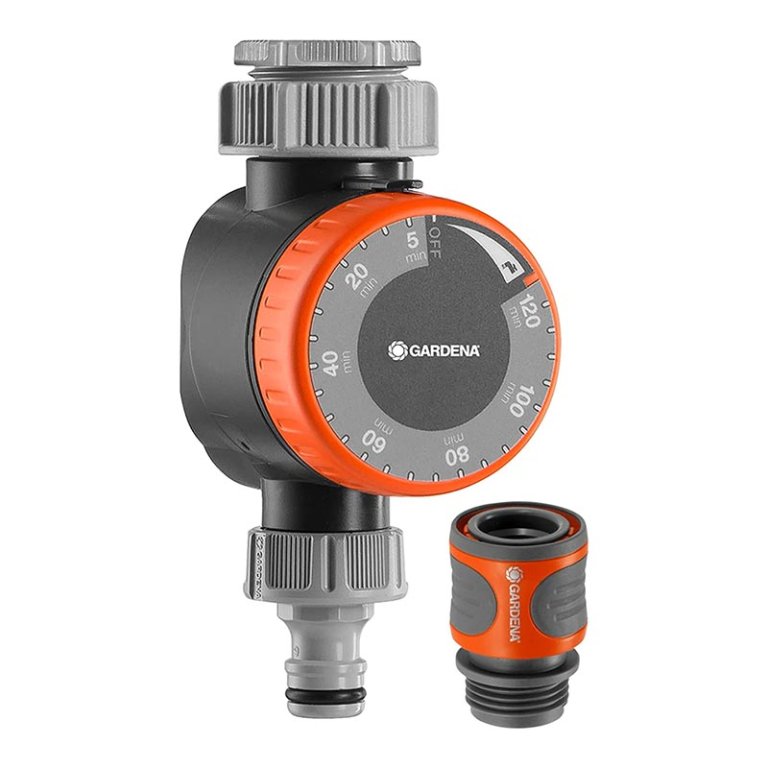
What We Like
- Super simple to set the timer—just turn the dial to the desired watering time
- No batteries required; the timer runs off an internal spring
- Budget-friendly and can be set to water for 5 to 120 minutes
What We Don’t Like
- Strictly manual—cannot be preprogrammed to water on a schedule
Product Specs
- Number of hose outlets: 1
- Watering duration: 5 minutes to 2 hours
- Digital or manual: Manual
Our Ratings: Ease of Use 4/5; Performance 4/5; Durability 4/5; Value 5/5
Sometimes less is more. We didn’t have to worry about batteries running down with the Gardena mechanical hose timer because this model is spring-loaded—no batteries are required.
Nothing could be simpler than turning the rotary dial to set the watering duration between 5 and 120 minutes (2 hours). As soon as we set the time, we heard a faint ticking sound from the timer—similar to a kitchen timer that works on a spring-loaded system. The timer is also accurate. We set it to 15 minutes, and after 15 minutes of watering, it shut the water off.
We could also leave the timer on the spigot but opt for manual operation by turning the dial to water-only mode. This allowed us to turn the water on and off as we pleased without using the timer function.
The Gardena timer doesn’t come with any bells and whistles, and it doesn’t offer preprogramming. Every time we wanted to use the timer, we had to set the dial manually, but it shuts the water off, and that’s its saving grace. Those with busy lifestyles who tend to turn on sprinklers but forget to turn them off don’t have to worry about flooding the yard and running up the water bill. When you set the Gardena timer, it’s OK to forget.
Get the Gardena hose timer at Amazon, Ace Hardware, or Wayfair.
Best Ease of Operation
Orbit 62056 One Outlet Single-Dial Hose Faucet Timer
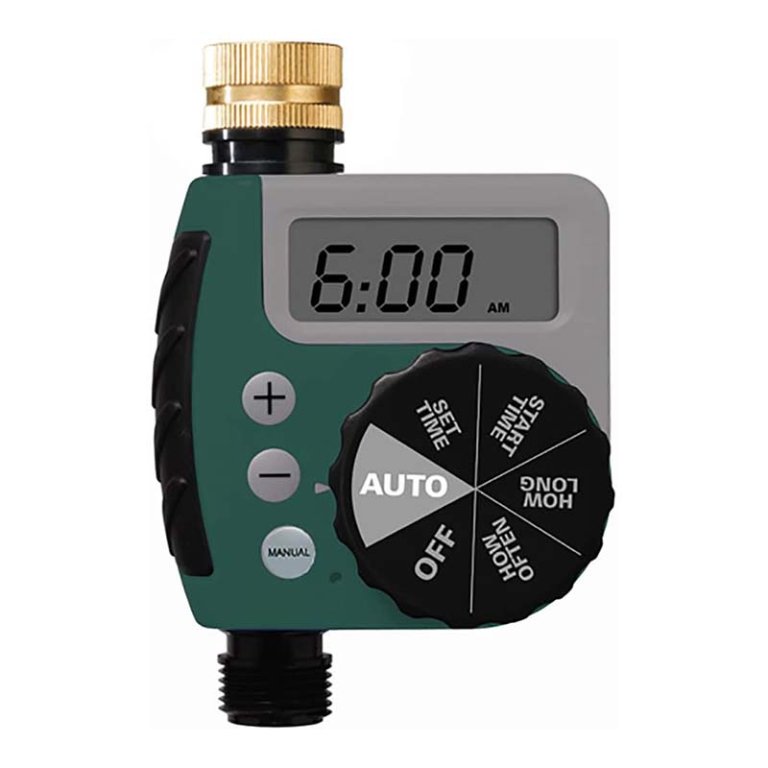
What We Like
- Programming is simple
- Rain-delay option pauses the program
- Manual override enables instant water control
What We Don’t Like
- Bright sunlight can make screen hard to read
Product Specs
- Number of hose outlets: 1
- Watering duration: Up to 4 hours
- Electronic or mechanical: Electronic
Our Ratings: Ease of Use 5/5; Performance 4/5; Durability 5/5; Value 4/5
After popping in two AA batteries (not included), we connected the Orbit timer to our outdoor spigot, attached a garden hose, and started testing. We immediately noticed how large and clearly marked the dial functions were—it was very easy to read them.
Using the dial, we were able to set the garden hose timer to water for as little as 1 minute to as long as 240 minutes (4 hours), and we were able to change the watering frequency anywhere from once every 6 hours to once every 7 days. Programming was simple: The Orbit timer features a six-function dial and plus and minus buttons for setting the clock and selecting how long and when to water. The Orbit timer also includes a rain-delay function and a manual override.
Overall, this hose timer is an excellent performer, but we didn’t love its digital screen. While the dial is large, the screen is on the small side, and it was challenging to see the readout in bright sunlight. Plus, it only has one water outlet, which may not be enough for some yards and gardens. We feel it’s best suited to small gardens or perhaps a drip irrigation system that runs off a single garden hose.
Get the Orbit 62056 hose timer at Amazon, Lowe’s, The Home Depot, Walmart, or Orbit.
Best 2 Outlet
Gilmour 804014-1001 Electronic Water Timer

What We Like
- Select from multiple start times per day
- Programming watering is simple
- Override and rain-delay function
What We Don’t Like
- Rain-delay function comes with a slight learning curve
Product Specs
- Number of hose outlets: 2
- Watering duration: Up to 6 hours
- Electronic or mechanical: Electronic
Our Ratings: Ease of Use 4/5; Performance 5/5; Durability 5/5; Value 5/5
With its dual-hose connections, the Gilmour electronic hose timer allowed us to control two separate watering zones automatically. It runs off two AA batteries (not included) and comes with an easy-attach spigot connector. We ran one hose to a traveling sprinkler and another to a drip system in a perennial border.
Programming each zone was easy. The Gilmour timer features L (left) and R (right) buttons for selecting each zone. We used the dial and the plus and minus buttons to set watering duration, frequency, and a specific start time for each zone. We were able to choose watering durations between 1 and 360 minutes and a watering frequency of every 6 hours, 12 hours, or up to 7 days.
This hose timer comes with a manual override for watering anytime and a rain-delay function that disables the timer for up to 72 hours. However, the rain delay function could be a little more user-friendly. To engage it, first select the “Run” feature on the dial and then press the plus button. It’s not intuitive, and we had to read the manual’s fine print to figure it out. Once learned, however, it’s easy to remember.
The digital screen is on the small side but is still easy to see and features a battery-charge indicator, which we appreciated.
Get the Gilmour hose timer at Amazon, Ace Hardware, or Walmart.
Best Smart
RainPoint Smart Wi-Fi 2-Zone Sprinkler Timer
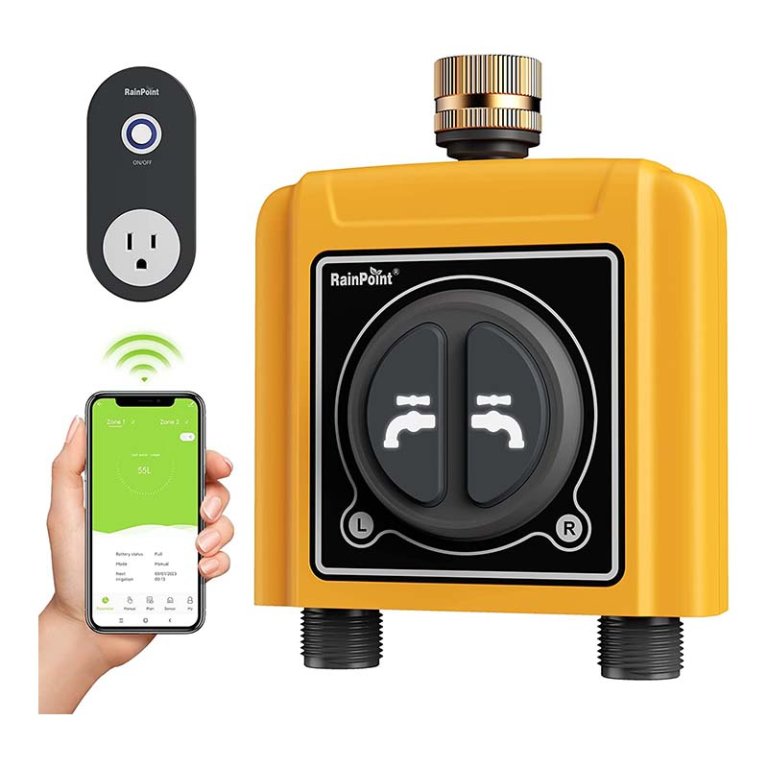
What We Like
- Wi-Fi and mobile app connectivity
- Watering programs are easy to set and change
- 2 watering zones that can be individually programmed
What We Don’t Like
- Costs about twice as much as a non-smart digital version
- Requires home Wi-Fi network and smartphone
Product Specs
- Number of hose outlets: 2
- Watering duration: Up to 11 hours and 59 minutes
- Electronic or mechanical: Electronic (on smartphone)
Our Ratings: Ease of Use 4/5; Performance 5/5; Durability 5/5; Value 4/5
Those looking to program or adjust a water timer remotely need look no further than the RainPoint Smart Wi-Fi hose timer. We’ve tested dozens of smart products, syncing them to our network and controlling them via smartphones, so we were excited to test this timer.
Physical installation begins just like other timers: simply insert four AA batteries (not included) and attach the dual-zone timer to an outdoor spigot. In testing, the RainPoint Smart’s easy-twist connector made this a snap. We then connected two hoses, one to a drip system and the other to a sprinkler in a flower bed.
That’s all we were able to do from the unit itself. To finish installation and set the watering programs for each zone, we then plugged in the included hub, downloaded the app on our smartphone (which required scanning a QR code on the packaging), and followed the instructions to sync the timer to our router. The sync process was easier than expected since the app walked us through the settings.
This is quite the hose timer! We could preprogram each of the two zones for specific durations from 1 minute to 11 hours 59 minutes and select particular days of the week for watering. In addition, we were able to program up to three separate watering plans for any given day. The app connected with local weather forecasts and notified us if rain was on the way, so we were able to pause watering for up to 72 hours. As if that wasn’t enough, we could set watering modes by the amount of water we wanted to dispense, from 1 gallon to 2,641 gallons.
The innovative features on this hose timer add so much versatility. The RainPoint Smart can also be used with a soil sensor that registers when the soil is dry or saturated and notifies users to adjust the watering programs. However, we didn’t have that sensor, so we couldn’t test that function.
This is the Cadillac of hose timers, but there is still one manual function: To water without the timer, simply push the unit’s left or right button to turn the water on or off.
Get the RainPoint Smart hose timer at Amazon or RainPoint.
How We Tested the Best Hose Timers
| Testing Stats | |
| Products tested | 10 |
| Time spent testing | 8 hours, plus monitoring |
| Tests performed | 10 |
| Price range | $20 to $100 |
Before conducting hands-on testing of hose timers, we researched more than two dozen models to identify options most highly rated and recommended by experts and consumers. We scoured online reviews and analyzed product specifications and features to decide which timers to include in our tests.
When testing hose timers, we started by attaching each one to a spigot and connecting it to a hose (or two, if applicable). Then, we reviewed the programming features, testing the timer’s ability to set watering schedules and adjust watering duration and frequency. We also tried additional features, such as rain delay or manual override, and assessed how easy the timer was to program and use.
We scored each timer using a rubric. The better a timer performed in each test, the more points it received. Overall, our goal was to comprehensively evaluate each timer’s performance and features to help you choose a hose timer for your own needs.
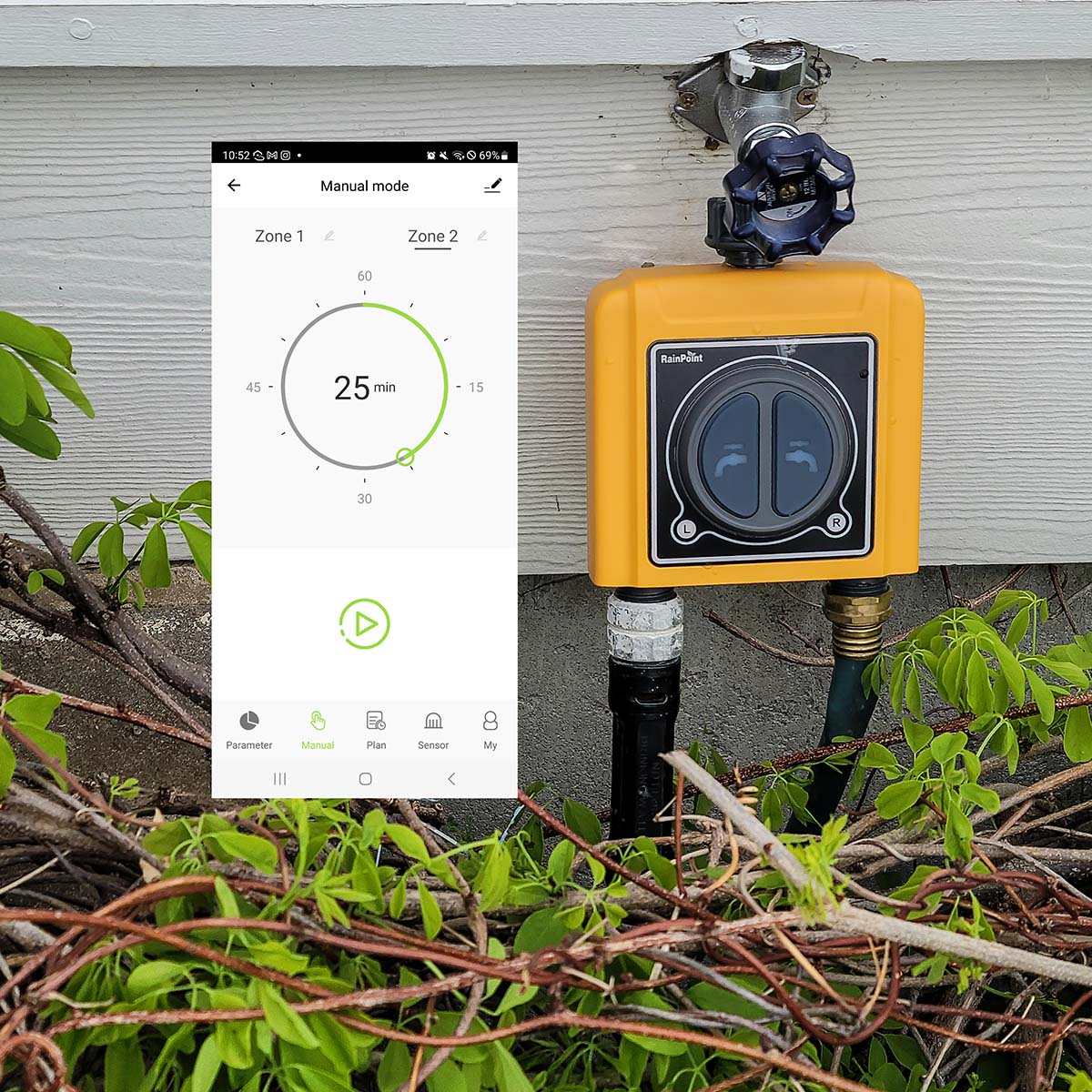
What to Consider When Choosing a Hose Timer
Before choosing the best hose timer for a lawn, garden, or irrigation system, it’s crucial to determine the type of hose timer needed, the available power source (if necessary), and whether it will connect to a smart-home system. Also, consider whether you want a hose timer that allows for multiple hoses and different zones to get total control over watering. Those who want to give the grass a good drink without flooding plants that are more prone to overwatering will especially want to look for such features.
Mechanical vs. Automatic
The first factor to decide on is whether the hose timer should be mechanical or if the lawn and garden would benefit more from an automatic hose timer.
- Mechanical hose timers have the benefit of simplicity. They don’t use electricity, so they won’t run out of battery power during a watering cycle. These options typically have a control dial that’s easy to use and understand. However, they don’t offer the same preprogramming benefits as automatic hose timers.
- Automatic hose timers are designed for the set-it-and-forget-it lifestyle. They can typically be programmed with a basic watering schedule that allows the timer to operate on its own, watering once or twice a day as scheduled. These hose timers also have transparent digital screens and may connect to smartphones or smart-home devices through Wi-Fi or Bluetooth. However, not all electronic hose timers are capable of these advanced functions.
Electronic vs. Solar
Powered hose timers differ in where they source the electricity, splitting them into two categories: electronic (battery-powered) and solar.
- Electronic hose timers are designed for use with a battery. Most of these products will operate on one or two AA batteries, though some smart hose timers may require more batteries for Wi-Fi or Bluetooth communication. The drawback with these hose timers is that the batteries will eventually run down and need replacing.
- Solar hose timers feature a digital screen and may even have some programmable functions outside of simply setting the timer. As the name suggests, this type of hose timer gets energy from the sun. Solar timers are not as common as battery-powered timers, and we didn’t test any, but for those with spigots on the south side of the house, they offer another option for watering.
Smart Technology
Smart technology is being rapidly adopted by those who want to outfit their homes with interconnected systems that automate appliances (or even help their gardens run on autopilot!). Even hose timers can harness this technology, offering remote access via Wi-Fi and Bluetooth connections.
- Wi-Fi–enabled smart hose timers connect to a smartphone or smart-home device using the home’s Wi-Fi. This allows them to communicate with digital devices so that users can set or adjust watering schedules through a phone, tablet, or via voice commands with a compatible smart-home device.
- Bluetooth-enabled smart hose timers also function through a connection with a digital device. Using Bluetooth, users can communicate with an app to adjust the watering schedule from a smartphone or table. However, this technology typically requires the device to be within about 150 feet of the timer—sometimes much closer.
Water Source
Residential hose timers are made to connect to standard outdoor spigots. Despite the diameter of the actual hose, such as ½ inch or ⅝ inch, the valves and fittings should all be compatible. Unless the hose timer specifies that it only fits a larger or smaller connector, there’s no need to worry about it fitting the home’s spigot.
Likewise, water pressure—measured as pounds per square inch (PSI)—usually isn’t a limiting factor, as hose timers are designed to withstand pressure exceeding most residential water-delivery systems. To be safe, it’s smart to check the product details and the manufacturer’s information to determine whether the hose timer has a maximum PSI. Also, note that commercial water pressure may be too much for a residential hose timer.
Zones
Grass, roses, daffodils, trees, and more can occupy the same yard. Since not every plant requires the same amount of water, some hose timers are designed to work with more than one hose to separate the yard into watering zones. This kind of categorization and individual control can allow the hose timer to water one area for 30 minutes, another area for 1 hour, a third area for 2 hours, and sometimes even a fourth zone for 3 hours, depending on how many outlets the timer offers.
Smothermon says that “it’s important to remember that not all plants need the same amount or frequency of watering. Fruit trees, perennial herbs, and organic vegetables should all be in different zones because they all have different watering requirements. Pick the type of plants or trees and set up a system specifically for each one.”
The ability to control more than one watering zone is also a good feature for larger yards where part of the lawn is in the shade while another part dries out quickly due to direct sun. In an instance like this, a dual-zone hose timer would shorten the watering time for the shaded area and conserve water.
Programmability
Whether they are battery-powered or solar-powered, most hose timers that run on electricity can be programmed for more than one watering cycle. In contrast, mechanical or spring-loaded timers can only be set for a single cycle. Programmability allows users to set up the watering schedule for the entire week and may extend up to a month or longer, depending on the specific product.
This is a beneficial feature for individuals who live in drought-prone locations because the hose timer can be set to a precise watering schedule, abiding by water-conservation regulations for the area.
Rain Technology
While automatic hose timers are great for programming a hands-off watering schedule, automatically turning the sprinklers on while it’s raining is pointless. Fortunately, manufacturers have devised solutions to this issue, including rain delay, rain sensing, and weather forecasting.
- Rain-delay functions are simple commands built into the hose timer that allow users to skip the watering cycle for the day. This function can be activated remotely if the hose timer connects through an app or smart-home device. Otherwise, users must manually skip the watering cycle at the hose timer.
- Rain-sensing functions are much more intuitive. A moisture sensor is embedded in the soil and connected to the hose timer. If the sensor detects saturated soil, the watering cycle is automatically canceled.
- Weather forecasting is specific to Wi-Fi– and Bluetooth-enabled devices. This feature considers the local forecast and adjusts the hose timer’s action based on the weather for the day. This method is only as accurate as the local weather forecast, so it may not be reliable 100 percent of the time.
FAQs
Still have questions about how hose timers work or how to maintain them properly? Read on to find the answers to some of the most common questions about these handy lawn-care tools.
All hose timers are water-resistant, but they are not all fully waterproof. However, remember that waterproof generally refers to the ability to be entirely submerged under multiple feet of water, a quality that a hose timer doesn’t really need. Hose timers only need to endure exposure to a lawn sprinkler, hose, rain, or water dripping from the user’s hands.
Hose timers should be inspected weekly or monthly, depending on the watering frequency, and replaced if leaks or cracks occur. Beyond this simple inspection, hose timers should also be removed before cold weather begins so as to prevent the timers from freezing and cracking.
If a hose timer is properly maintained, it can last from 1 to 3 years before needing to be replaced. Smothermon says that “as long as the rubber inserts/gaskets inside the timer and inside the hoses are replaced every year or so, the systems typically remain leak-free.”
Hose timers can pay for themselves by keeping expensive landscape and garden plants alive while conserving water.
If freezing temperatures are in the forecast, a running hose may be the source of icy sidewalks, driveways, or streets. Running sprinklers overnight could lead to disease problems with plants in some cases, so consider a smart sprinkler to program the sprinkler for specific times.
Some hose timers require batteries, others operate mechanically without electricity.
When the season is over, drain any remaining water from the hose timer and allow it to air dry before storing it. Store it in a dry location.
Water consumption over time depends on several wide-ranging variables, including local water pressure, hose length, hose end attachment, and more. Domestic water pressure alone ranges by location, anywhere from 45 to 80 PSI. The best way to estimate water usage is to collect the water from the hose for 1 minute, measure the amount collected, and multiply by 60 for a volume-per-hour projection.
Meet the Tester
Glenda Taylor is a product tester, writer, and co-owner of a general contracting company. She tests a wide range of power tools as well as other home improvement, household, and lawn-and-garden products.
Mark Wolfe is a product tester and writer with a prior career in the nursery and landscaping industry. For twenty years, he mowed, edged, planted, pruned, cultivated, irrigated, and renovated beautiful landscapes. Now he tests and writes reviews about the latest hand tools, lawn care products, outdoor power equipment, and other outdoor living goods.
Additional research provided by Timothy Dale.
Source link


